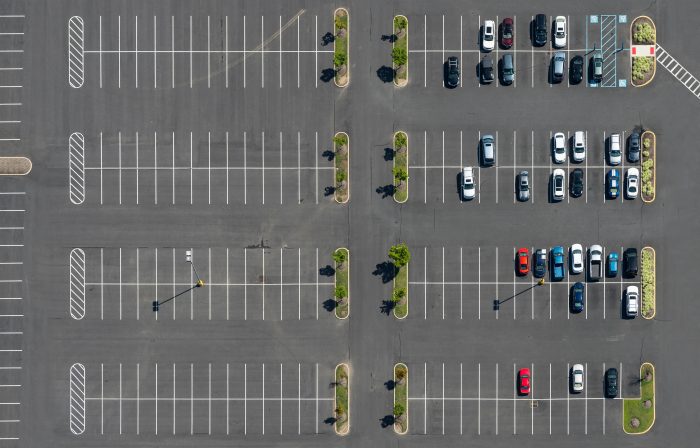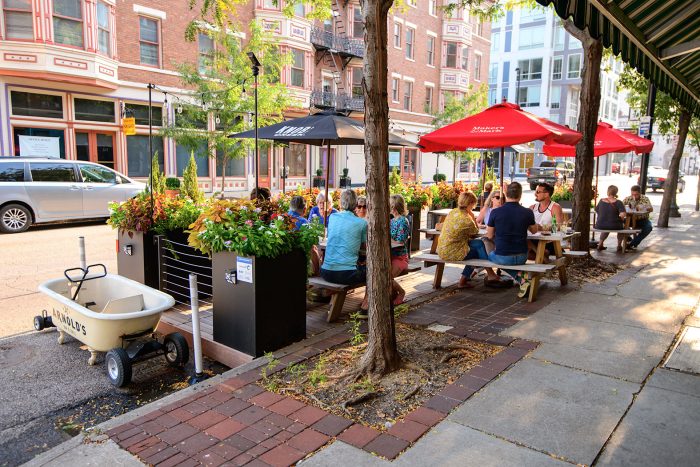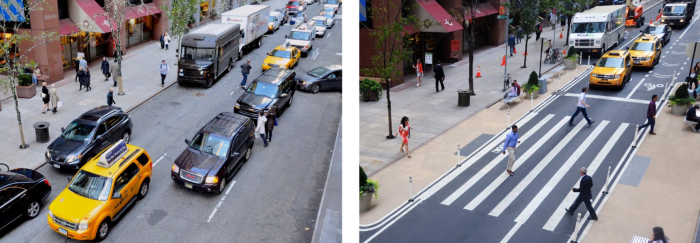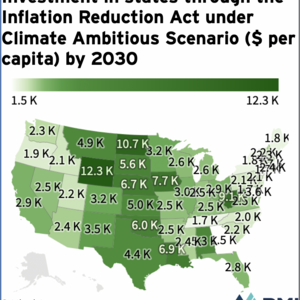
In 2015, Chris Meyer was working the night shift at a Minneapolis apartment building when he decided to assign some light reading to the city council. He bought each of its members a copy of an 800-page textbook he had read—unassigned—in college. The High Cost of Free Parking, by UCLA planning professor Donald Shoup, lays out how America’s expectation of abundant and cheap parking has distorted our architecture, housing costs, transportation patterns, and environment.
Minneapolis stopped requiring parking spaces in most new buildings that year, and eliminated the requirements entirely just a few years later. Those laws, also referred to as parking minimums or mandates, blanket municipal codes in the United States, forcing builders to include a substantial quantity of parking with every new home, office, shop, or school. Those parking spaces cost a lot of money to build, and they sit empty most of the time.
“The reforms made housing more affordable and reduced dependence on cars,” said Meyer, now a Minneapolis planning commissioner and legislative assistant to Minnesota state senator Omar Fateh. “They helped us move towards the goal of getting more people and fewer cars in the city, which is what we need to do.”
Earlier this month, Fateh announced the People Over Parking Act, a bill to eliminate parking requirements across the whole state. He explained how a church in his Minneapolis district was able to be converted to affordable housing after the city’s policy change. This time around, Meyer bought 130 parking policy textbooks for members of the state legislature; a plastic table in the State Capitol building buckled under their weight.
It has felt, lately, like cities across the U.S. are living in one of Don Shoup’s favorite New Yorker cartoons, by Edward Koren, which shows a group of adults gesticulating wildly over canapés: “The conversation has turned to parking.”
The premise of parking reform is only partly about parking. More broadly, reformers argue, bad parking policy inhibits many of the things we say we want from our cities: Things like affordable housing, a walkable neighborhood, attractive architecture, a greener, cleaner city. Parking is a central component of the transportation-land use mess that has left so many Americans dependent on two or more cars per household. Parking lots are an environmental disaster twice over, consuming vast quantities of materials and land while they subsidize endless driving. That’s the bad news.

The good news is that parking is changeable. Focus more on the place, and less on the place to park, and the barriers to a better urban environment begin to fall away. Says Tony Jordan, who in 2019 cofounded the Parking Reform Network, which aims to correct the country’s wayward parking policies, “What we’ve been doing is so clearly bonkers that when you point it out, a good number of people are like, ‘This is bonkers!’”
Minneapolis, San Francisco, Buffalo, Hartford, Austin, San Jose, and Portland, Oregon, have all stopped requiring parking in the last decade. So have college towns like Champaign, Illinois, Berkeley, California, and Cambridge, Massachusetts. California and Oregon have each chipped away at parking minimums in urban areas. There is even a federal bill, introduced in Congress last spring, that allows property owners to decide how many parking spots to provide for new developments.
These changes have been accompanied in many cities by a new approach to managing street parking at the curb, a long-neglected component of urban infrastructure. The common problem with curb parking is that it is too cheap. All-day parkers (often, local employees) arrive first thing in the morning and take the best spots, leaving visitors to cruise in frustration—a phenomenon that appears to account for a sizable share of traffic in congested places.
In San Francisco, meter rates now rise and fall once a month according to how hard it is to find a parking space, with the goal of a free spot on every block. To sweeten the deal for local merchants who fear losing clientele to suburban shopping centers, some cities have re-invested meter money in local improvements.
These trends have been underway for a decade, but they received a jolt in 2020 when the Covid-19 pandemic forced communities to reckon with their paucity of outdoor public space. Restaurant tables bloomed in thousands of parking spaces, and streets that had once been lined with silent machines were transformed into festival scenes.
The masks have faded away, but the lesson—that this space can be used for something besides parking—has lingered. Cincinnati has spent millions to help restaurants establish permanent “streateries”; New York has decided to “daylight” thousands of intersections, removing parking spots near crosswalks so drivers can more easily see pedestrians and bicyclists. Other cities have used curbside parking for green space, EV charging, bus lanes, bike lanes, and bike parking.

Parking is a promising target for visionaries because the bullseye is so large: We have at least three spaces per car, nationally, and more in some cities. We ended up with this parking surplus in part because of our failure to properly manage the shared, public parking supply. Instead, we required each element of the city to supply its own private parking, a recipe for excess that spurs customers to drive from destination to destination, even when those places are right next to each other.
Environmentalists are newly focused on parking’s many ills, including vanished natural areas, heat island effects, stormwater flooding, light pollution, and the use of massive quantities of asphalt and concrete. Parking occupies a double-digit share of the land in most metro areas, and more than a third of some downtowns. But the most serious environmental impact of free parking may be how it encourages driving. One recent federal study projected that if employees who get free parking at work received an equivalent bonus for not using that parking, traffic in major cities would fall by 10 percent, with equivalent drops in fuel consumption, pollution, and emissions. Free parking is also a strong predictor of car ownership; paid parking is a strong predictor of transit use. If you want less traffic, parking policy is the place to start.
For younger generations concerned about the high cost of housing, parking is also under attack. Study after study shows that parking minimums add tens of thousands of dollars onto the cost of new housing units while suppressing low-rise, multifamily, and affordable housing. As the requirements fall away, architects and developers have responded by building more housing and less parking than they used to in cities like Seattle and Buffalo. New types of housing, such as accessory dwelling units (ADUs), have flourished in the absence of parking mandates—in California, ADUs now account for one in five new housing units.
Lori Droste, who sits on the city council in Berkeley, tried to capture parking’s power in her first legislative proposal to change the zoning code, in 2015. “It was all parking reform,” she said, laughing. “But I called it the Green Affordable Housing Package.” The city ended parking mandates in 2021. Statewide, a bill signed in 2022 prohibits parking minimums for buildings within a half mile of major transit stops.
In Oregon, new rules compel the state’s jurisdictions to change their zoning to allow developments without parking. In response, some developers have replaced parking with housing. “People think this is a big-city reform,” said Catie Gould, senior transportation researcher with Sightline, a think tank based in Seattle. “But it’s really neat, we have smaller cities and more rural areas affected by this reform.” Even in a place where everyone drives, she says, it turns out that street parking can often handle the demand just fine.

That parking reformers—a loose coalition of environmentalists, affordable housing activists, architects, developers, business owners, cyclists, pedestrians, and straphangers—have succeeded in changing so many parking policies over the last decade is all the more surprising given Americans’ fierce attachment to their parking spots.
Simply put, we’ve built a world where we have to drive everywhere, which means that parking is very important to us. And while paying for parking can be seen as a hardship, the chaos of underpriced parking has imposed greater costs (traffic, pollution, lost time, lack of access to parking) and led to parking requirements that inhibit the creation of affordable housing. Walking even a few minutes from a parking spot feels like an affront, even if we’d do the same without a second thought at a shopping mall.
Municipal officials supporting parking reform do their best to assuage fears of a parking shortage, reminding wary constituents that changing the parking code won’t take away existing parking. “The big thing we wanted to make clear was: This won’t eliminate a single parking space,” said Zo Qadri, an Austin councilor who authored the repeal in the Texas capital, the largest U.S. city to do so. Adding parking meters and increasing rates are a slightly tougher sell, but those tactics have also been deployed with success in Austin, with local businesses coming around to the idea that it is the lack of parking, rather than its price, that keeps clients away.
The core tenet of parking reform, which is rarely highlighted at city council meetings, is that ultimately our communities might be better off if it were a little bit more difficult or more expensive to park in the heart of town. But it may need to be so if we hope to build a safer and more convenient environment for nondrivers.
Many global cities are operating with those ideas as axioms. London and Mexico City have scrapped their parking requirements. Japan mostly prohibits overnight car storage at the curb. If you buy a car, you need your own parking space. Leaders in Amsterdam and Paris, with their excellent transit service and lower rates of car ownership, have boasted about making it harder to park—something that would be nearly unimaginable even in walkable U.S. cities like Boston or Chicago. Our international peers have also been more ambitious in repurposing that parking. In Amsterdam, some street parking has become urban forest; in Paris, entire blocks outside schools have been repurposed as social spaces for kids.
All that is possible in U.S. cities too. But first leaders must legalize the type of parking-lite, high-density housing that makes it possible for a neighborhood to be vibrant, walkable, and economically served by mass transit. That’s the beautiful thing about taking away parking: The less of it you build, the less you need. And the places where the parking fight is the most intense—South Philadelphia, Koreatown in Los Angeles, Boston’s North End — are precisely the ones where it’s easiest to live without a car in the first place.
Henry Grabar is a Loeb Fellow at the Harvard Graduate School of Design, a staff writer at Slate, and the author of Paved Paradise: How Parking Explains the World. This article originally appeared on Yale Environment 360 on January 31, 2024. It is republished here with their permission.
Weekly Newsletter
Get building science and energy efficiency advice, plus special offers, in your inbox.













3 Comments
This is a welcome column. I can't think of an issue that has been more damaging to cities, and the planet even, than the prioritizing of (mostly) single occupancy car transportation.
The elimination of parking requirement is a good first step but insufficient. The long list of consequences of one-car per adult includes pollution/climate change, wildlife eradication, dangerous/unwalkable environments, social isolation, increased obesity, unaffordable housing and hostile public spaces where few parents can leave their kid run outside freely.
It’s not getting better now that the market for new vehicle in the US is over 80% trucks and SUVs. And it won't get better until we start charging motor vehicles appropriately for all the negative side effects.
And as with many things, the rest of the world is quickly adopting america's worst conspicuous consumption habits. Over 50% of new vehicles sold in Europe are now SUVs.
China went from producing 2 million motor vehicles in 2000 to over 30 million in 2023 -compared to 10 to 12 million/year produced in the US during that time period. With its economic and political ambitions and edge on electric vehicle, China’s production is bound to grow even faster in the coming years.
For a bit of comic relief, this is what some Chinese manufacturer are doing when trying to surpass the machismo of american car manufacturers. Spoiler alert; this SUV comes with handgun-shaped door handles and an optional tactical drone.
https://www.youtube.com/watch?v=l9ZonXw5a98&t=33s
Vivian,
A cartoon by architect Leon Krier
Ah, I think that these projectiles are aimed directly at Lloyd Alter and I :)
Log in or create an account to post a comment.
Sign up Log in